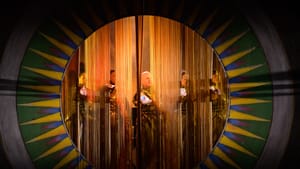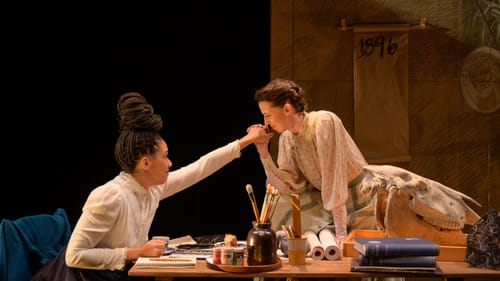Stay in the Loop
BSR publishes on a weekly schedule, with an email newsletter every Wednesday and Thursday morning. There’s no paywall, and subscribing is always free.
Women artists still deserve better
The Wilma’s Hilma does not do justice to Hilma af Klint’s art, life, or legacy

Bring to mind that sinking feeling of watching a lousy Hollywood adaptation of a favorite book and combine it with a child’s devastation when their peers mock a topic of intense interest. That’s how I felt watching the world premiere of Hilma, the new contemporary opera by composer Robert M. Johanson and librettist Kate Scelsa, onstage at the Wilma through June 23, 2024 (and streaming from June 24 to July 21).
Art that speaks back
Art has moved me in profound ways all my life, and sometimes its beauty makes me cry. But I never heard it speak until I saw the 2018 exhibition, Hilma af Klint: Paintings for the Future, at the Guggenheim.
The Guggenheim exhibition introduced many to af Klint (1862-1944), the Swedish painter now considered a pioneer of modernism and abstraction, but I discovered her earlier on a free artist-of-the-day app. My graduate study included research on women and modernism, but af Klint never came up—her work remained largely unseen until the show at the Guggenheim. Prior to that, tiny images of her paintings on my phone made me a fan of them, their symbology, and the complex philosophy beneath them. I made a pilgrimage to New York and later returned a second time. Seeing af Klint’s paintings in person was an otherworldly experience, even for one so freely moved.
Dazzled by af Klint’s art and at a crossroads in my life, I stood before one and silently asked it a personal question. Never before had I done such a thing, and I hardly expected a response. The painting replied quickly, though; its answer silent as my question but perfectly clear. Likely the voice was my own, speaking wisdom that my busy brain otherwise could not hear. Nevertheless, the uncanny experience fits such mystical art.
Séances, poetry, painting, and the soul
A devotee of Theosophy since the death of her sister, af Klint believed that enlightened spiritual beings dictated the paintings to her. For years, she participated in séances with a group of five women, seeking meaning and truth during the rapid changes of the turn of the 20th century. Séances aside, af Klint’s context and her response to it feel contemporary. Her insistent searching and urge to visually reconcile binaries like male and female or youth and age relate to the 21st century as well as the 20th. Meanwhile, the artist’s use of color, scale, and abstraction during a time when no one else made non-representational art resonates with me.
So do her legacy and reception, which remind me of another artist I admire. Like the American poet Emily Dickinson, af Klint did not share her art during her lifetime. Rather, she hid it away, leaving instructions to wait 20 years after her death before showing it. According to Hilma dramaturg Jackie Tileston, “She understood that the world was not ready for her work.” I often think of Dickinson in the same way, since the images and unique structures of her poems now seem to anticipate the literary modernism that emerged decades after her death. Similarly, the famously private writer also addresses metaphysical topics like consciousness and the soul. But unlike Dickinson, af Klint meant to share her work, eventually. She intended for her paintings to be displayed in a temple with a spiral, perhaps envisioning their future hanging along the spiral ramp of the Guggenheim, drawing record crowds.
Missing Hilma
Af Klint’s art has hung in my home and office since the exhibition, and I eagerly anticipated Hilma. It could have introduced more people to af Klint and developed more interest in her life and work. At best, Hilma treats its subject as an afterthought (Cameron Kelsall agrees in his review). At worst, it makes a mockery of her.
The production spends more time on Theosophy, the artist’s potential relationships, and the creators’ thoughts and feelings about her than af Klint herself. Hilma (Kristen Sieh) appears only in the first act, which focuses on her creation of the artistic commission received by her spiritual group without showing her art or creative process. Worse, Hilma is organized around assumptions about the artist, her beliefs, and her life that fail to clarify anything.

The production explores af Klint’s spirituality without explaining Theosophy, a difficult concept to grasp. The second act set in “the astral plane” is a cringeworthy faux kumbaya with ridiculous costumes and long instrumental solos. The first and third acts emphasize af Klint’s possible relationship with Anna (J Moliére), a member of her spiritual group, without relating this to the art. Homophobic straightwashing makes it important to name and reclaim historical figures whom we know or believe were queer or trans, but not at the expense of celebrating their contributions. Hilma offers a song about Hilma and Anna taking a trip to Munsö, but it never mentions that af Klint created purely abstract works before male artists like Piet Mondrian and Wassily Kandinsky, who are usually credited with developing modernism.
Women artists are still fighting to be seen
Painfully loud, discordant music paired with indistinct lyrics, weak singing, and underdeveloped choreography added to the production’s flaws. Af Klint deserves better than Hilma. So do fans of her art. Unfortunately, women artists still receive inadequate credit, attention, and representation. What little they get tends to treat them differently than men. It’s hard to imagine a show about a male artist organized like Hilma, and that is a keen disappointment for lovers of af Klint’s art. Ultimately, Hilma does not do justice to it, her life, or legacy, nor does it pave the way for more performances about women and their lives.
What, When, Where
Hilma. By Kate Scelsa and Robert M. Johanson, directed by Morgan Green. $29-$80. Co-production of Wilma Theater and New Georges. Onstage through June 23, 2024, at the Wilma Theater, 265 S Broad Street, Philadelphia; streaming June 24 through July 21, 2024. (215) 546-7824 or wilmatheater.org.
Accessibility
The Wilma Theater is a wheelchair-accessible space with all-gender restrooms.
A streaming version of Hilma ($29) will be available from June 24 through July 21, 2024.
Sign up for our newsletter
All of the week's new articles, all in one place. Sign up for the free weekly BSR newsletters, and don't miss a conversation.

 Melissa Strong
Melissa Strong